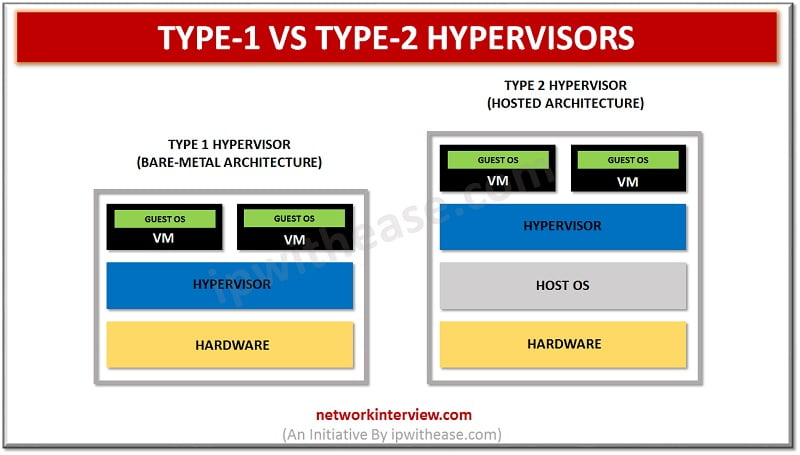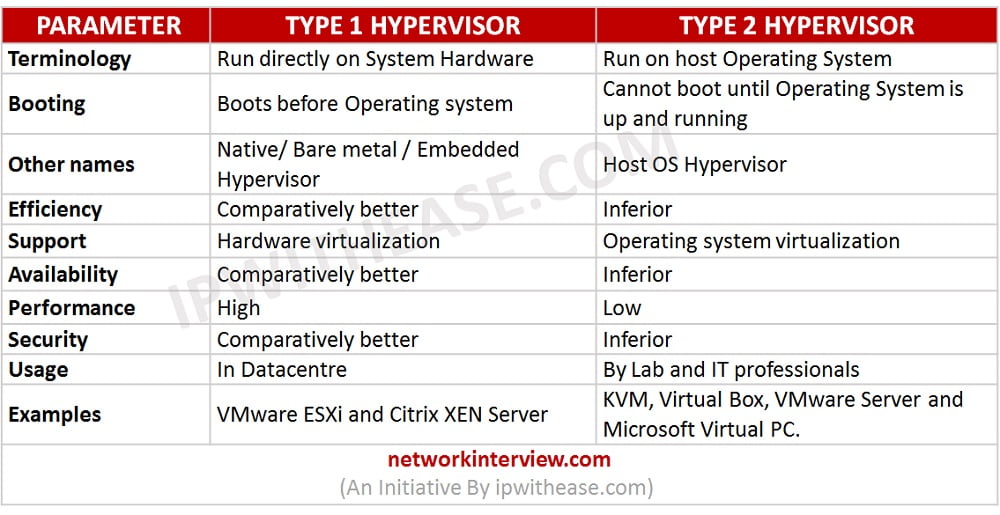
Type-1 vs Type-2 Hypervisors
Type-1 vs Type-2 Hypervisors
Server virtualization is perhaps the sultriest point in the IT world today. It has been around for a long time, and its ubiquity continues developing, particularly in big business environments.
What makes virtualization conceivable in hypervisors?
Server virtualization permits distinctive working frameworks running separate applications on one server while as yet utilizing the equivalent physical assets. These virtual machines make it workable for a framework and system managers to have a committed machine for each service they have to run.
In addition to the fact that this reduces the quantity of physical servers required, yet in addition spares time while attempting to pinpoint issues.
What are Hypervisors?
Hypervisors are a pivotal bit of programming that makes virtualization conceivable. Fundamentally, hypervisors make a virtualization layer that isolates CPU/Processors, RAM and other physical assets from the virtual machines you make.
The machine we introduce a hypervisor on is known as a host machine, instead of visitor virtual machines that sudden spike in demand for top of them.
Hypervisors imitate accessible assets with the goal that visitor machines can utilize them. Regardless of what working framework you boot up with a virtual machine, it will feel that genuine physical equipment is available to its.
From a VM’s viewpoint, there is no distinction between the physical and virtualized condition. Visitor machines do not have a clue about the hypervisor made them in a virtual domain and that they share the accessible processing power. Since virtual machines run all the while with the software that forces them, they are completely subject to their steady activity. There can be two types of hypervisor:
- Type 1 Hypervisor.
- Type 2 Hypervisor.
Type-1 vs Type-2 Hypervisors: Difference Table
PARAMETER | TYPE 1 HYPERVISOR | TYPE 2 HYPERVISOR |
| Terminology | Run directly on System Hardware | Run on host Operating System |
| Booting | Boots before Operating system | Cannot boot until Operating System is up and running |
| Other names | Native/ Bare metal / Embedded Hypervisor | Host OS Hypervisor |
| Efficiency | Comparatively better | Inferior |
| Support | Hardware virtualization | Operating system virtualization |
| Availability | Comparatively better | Inferior |
| Performance | High | Low |
| Security | Comparatively better | Inferior |
| Usage | In Datacentre | By Lab and IT professionals |
| Examples | VMware ESXi and Citrix XEN Server | KVM, Virtual Box, VMware Server and Microsoft Virtual PC. |
Download the difference table: Type-1 vs Type-2 Hypervisors
Type 1 Hypervisor
It runs directly in the host’s hardware to manage guest operating system. There is a direct access of hardware and does not requires any base server operating system. It has better performance, scalability and stability but supported by limited hardware. Type 1 Hypervisor is called by names also i.e. Bare Metal Hypervisor or native Hypervisor. Based on its features, Type 1 Hypervisors are suitable or use in Datacentre environment
Type 2 Hypervisor
This type of hypervisor is hosted on the main operating system. Basically, a software installed on an OS and hypervisor ask the OS to make hardware calls. It also has the better compatibility with the hardware and its increased overhead affects the performance.
Type-1 vs Type-2 Hypervisors: Which one to pick?
Picking the correct kind of hypervisor carefully relies upon your individual needs.
On a macro level, 2 key considerations need to be taken into account while selecting the Hypervisor to be used.
- First one is “SIZE” of the virtual environment where the hypervisor needs to run. For individual use and small organizations, you can go for one of the type 2 hypervisors, if financial limit is not an issue. Things get complicated in large business environments where we need to be more prudent and accordingly take a judicious call.
- Second consideration is “Cost”. Despite the fact that type 1 hypervisors are the best approach, cost may play a big role in Hypervisor selection. This is where you have to give additional attention since cost might be per server, per CPU or even per center.
Numerous merchants offer various items and layers of licenses to suit any association. You might need to make a rundown of the prerequisites, for example, what number of VMs you need, maximum permitted assets per VM, specific functionalities, and afterward check which of these items’ best fits in. Note that trial period can be gainful when settling on a choice which hypervisor to pick.
Also refer: Top 5 Type-1 Hypervisors in Market
Watch Related Video
Tag:comparison, virtualization




